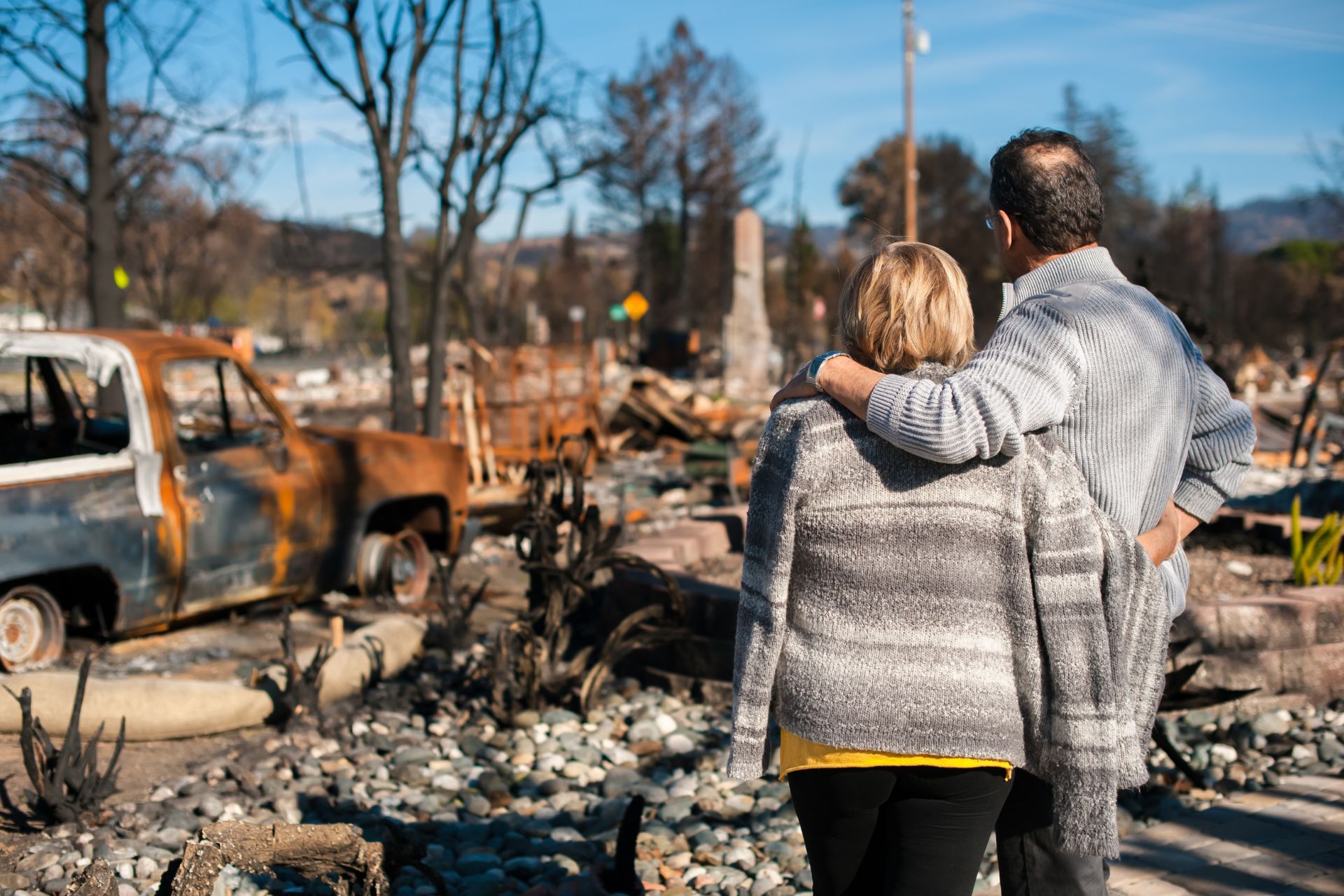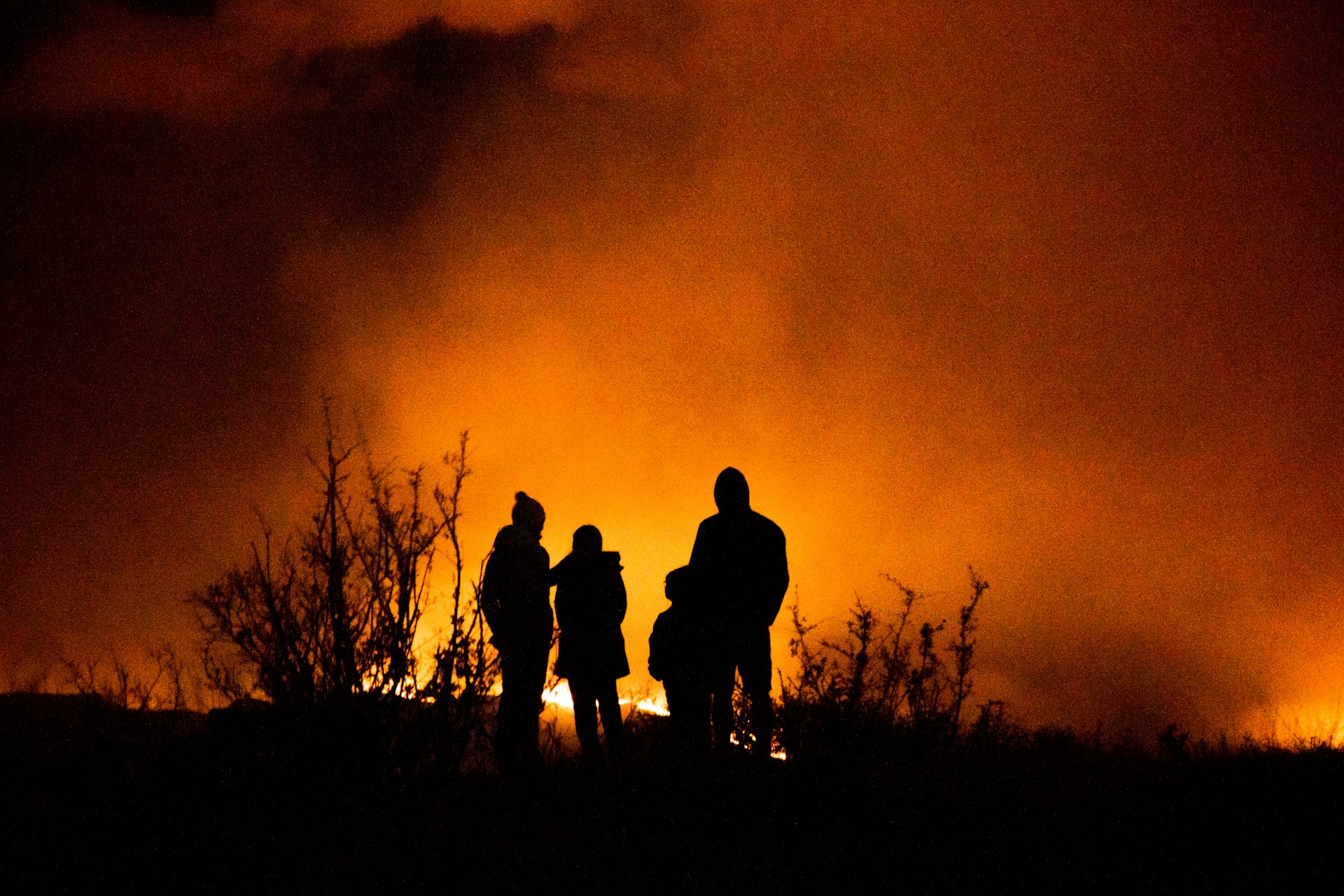
Yes, insurance does provide coverage for losses in a wildfire to a certain extent. However, there are often limits to how much someone can receive. There are many cases when the insurance company’s payout falls well short of the actual cost of rebuilding, making repairs, and replacing personal belongings that were damaged or lost.
This question has been on our mind a lot given the increased number of wildfires throughout California. As our Eaton Fire lawsuit attorneys speak with potential claimants in Los Angeles, there have been many questions regarding homeowners’ insurance and seeking damages from Southern California Edison (SCE).
Below, we explore some common issues surrounding insurance and wildfires in California, and why it’s worth speaking with a lawyer when fires are caused by a utility company’s negligence. If you were affected by the Eaton Fire or other utility-company-related disasters, Danko Meredith can help. To share your story with our California wildfire attorneys, contact our Bay Area law firm online or give us a call at (650) 453-3600. Consultations are free.
Insurance Coverage in a California Wildfire
Those who have homeowners’ insurance will likely receive some amount of coverage following a wildfire. The amount of coverage will vary depending on your policy and any exclusions.
If you have homeowners’ insurance, your policy will likely cover damage to your home, damage to personal property in your home (e.g., furniture, clothing, electronics), damage to other structures on your property, and the removal of wildfire debris from the premises. You may also receive coverage for any temporary living expenses incurred because of the wildfire.
If you have renter’s insurance, your policy will likely cover damage to personal belongings as well as temporary living expenses while your rental is not habitable. In addition, auto insurance may cover vehicle damage or the loss of a vehicle during a wildfire.
Can I Collect Insurance Money and Also Sue a Utility Company That Started a Wildfire?
Potentially, yes, but you will not be able to recover compensation from a utility company for the same damages covered by your insurance. Many insurance companies have subrogation rights, meaning that they can sue a utility company on your behalf to recover the amount they paid you.
You cannot seek a double recovery, you can still sue the utility company for uninsured losses. This includes things such as emotional distress, pain and suffering, injuries or illness caused by the fire, and possibly even property that was not insured.
Shortcomings in Insurance Coverage After a Wildfire
Unfortunately, insurance companies are businesses, which means they’ll do whatever they can to save money even when policyholders are between homes or trying to figure out their financial situation. Some potential difficulties people face after a wildfire include:
- Underinsurance and Undervaluing Losses: Just because you have insurance doesn’t mean it’s enough to cover your lost property and fully rebuild. Insurance companies may disagree about the value of your home and belongings affected by the wildfire. Many people who lose a home in a wildfire get settlement offers that underestimate their losses by tens of thousands of dollars, sometimes more.
- Damage Caused by Smoke, Soot, and Ash: When trying to repair a home, many insurers try to downplay the extent of damage caused by smoke and ash. It can cost thousands to remove all of the hazardous particulate matter left behind by a wildfire. We’ve recently discussed the dangers of smoke damage in the Eaton Fire, and it’s worth reiterating here. Failing to clear out smoke, soot, and ash from a home or business can increase your risk of developing serious respiratory and cardiovascular problems.
- Delayed Payments: After massive wildfires in California, insurers may take a lot of time to distribute payments to policyholders. This is to be expected when there is a large volume of claims to evaluate, but each day waiting on a payment compounds the financial anxieties of someone displaced by a wildfire. Delays could also mean higher costs to rebuild or make repairs when payments are finally distributed.
- Delayed Communication: Delayed payments aren’t the only unfortunate waiting game after a wildfire. Some insurers do not return calls or emails promptly, leaving wildfire survivors in a tense holding pattern. These delays in communication may be due to a high volume of claims to process or, in some cases, this may be a stalling tactic used in bad faith to force desperate policyholders to accept a lowball settlement.
- Disputes and Claim Denials: Insurers may dispute certain losses or deny a homeowner’s claim entirely. Companies may cite missed premium payments, a lack of documentation regarding specific losses, exclusions in the policy, or language hidden in the fine print. You can appeal the denied claim, but that is often a long and time-consuming process.

Ways to Address Potential Insurance Issues After a Wildfire
There are a few things you can do if you encounter the issues listed above.
- Document Everything: If you have any photos or videos of your home and the contents within prior to the fire, retain them as evidence of your damaged property. Also take photos or videos of the fire damage and hold on to all of your receipts after the wildfire.
- Start a Claim Journal: Track all of your communication related to the wildfire and the insurance company. Log phone calls, make copies of emails, and keep copies of any documents sent to you in the mail.
- Get Your Own Rebuild Estimates: Consult a qualified expert to provide their estimate of repair or rebuilding costs. Their estimate may be more accurate.
- Consider Hiring an Attorney: Dealing with insurance companies is frustrating and complicated. Get legal help from an attorney you trust to help you navigate the appeals process and handle any disputes.
Challenges Getting Insured in Fire-Prone Parts of California
It’s not just a challenge getting insurance companies to provide fair compensation. As the risk of wildfires has increased throughout California, getting insured for wildfire damage has become far more difficult.
If you’re in a fire-prone part of California, you’ll likely have to pay much higher premiums if you can even get insured. You may even need to have special add-ons depending on where you live and its wildfire risk.
For those unable to obtain coverage, there is potential enrollment in California’s FAIR Plan, a basic fire insurance plan of last resort for homes and businesses with a high wildfire risk. However, KPIX/CBS News reported that homes that are considered low-risk for wildfires are being forced onto the FAIR Plan. This is because California homeowners in general are unable to get insured for wildfires.
Understanding the Wildland-Urban Interface
One of the biggest issues regarding insurance coverage and wildfire management is the Wildland-Urban Interface (WUI). This is where cities or suburbs meet the outskirts of the wild. This also refers to businesses and residences that are surrounded by forest or grassland.
Building in the WUI has been a common practice to meet the housing demand in the state. Yet climate change and extreme weather have meant that more and more communities now face heightened wildfire risk.
Countless WUI Homes Are in Danger During a Fire
According to the Insurance Information Institute, there are 1.25 million homes in California that are at risk for extreme wildfires. That number is high, but there are significantly more houses in danger during a wildfire because they’re in the WUI. Countless neighborhoods throughout California are in the WUI. Think of the homes along the hillsides of the North Bay and along the Peninsula, or cities in Northern and Southern California that are near wooded mountains and forests.
If you recall the Tubbs Fire in 2017, the blaze started in Wine Country and spread to Santa Rosa. The fire destroyed more than 2,800 homes in the city and caused $1.2 billion in damage. This and the devastation in Altadena during the Eaton Fire should highlight the dangers for many neighborhoods as wildfires become the new normal.

Why You Need to Speak with a Lawyer After a Wildfire
After a wildfire, you may feel overwhelmed or unsure of what to do. Your focus is on finding a place to live and making sure your family is cared for.
By speaking with California wildfire lawyers, you’ll receive insight into what steps you should take to help secure compensation. If the wildfire was caused by a utility company, your attorney can discuss legal action that can secure further compensation.
Without an attorney, you may wind up accepting a lowball settlement from your insurance company that falls well short of your actual losses. You could also fall for PR stunts by a negligent utility company used to minimize payouts (which is what SoCal Edison is doing with their claims program). Your lawyer can steer you in a better direction and help you consider your best interests.
What Are Utility-Caused Wildfires?
Utility fires are a subset of human-caused wildfires. This refers to cases in which equipment from a utility company ignites nearby vegetation, leading to a wildfire. In these cases, Pacific Gas & Electric (PG&E), San Diego Gas & Electric (SDG&E), and SoCal Edison can be held liable for damages.
Common Causes of Utility Wildfires
Utility wildfires usually have three causes:
- Failure to Repair or Maintain Electrical Equipment: This is when a utility company does not repair or maintain its transmission towers, power lines, or other equipment. The companies believe it’s more cost-effective to let this equipment fail rather than fix it. A run-to-failure mentality like this endangers millions of people all over California.
- Failure to Clear Trees from Towers and Power Lines: Many transmission towers and power lines are located in forested areas with a lot of dry brush. Utility companies must keep trees and tree limbs away from power lines. If a tree hits a tower, it can ignite a fire that can spread quickly.
- Failure to Shut Off Power During Heavy Winds: Heavy winds can cause power lines to swing. If live power lines touch one another, it can cause sparks that can ignite the vegetation nearby. Power companies can shut off power as a precautionary measure, but sometimes they fail to do so, resulting in massive wildfires.
Examples of Utility Wildfires in California
There have been some notable utility wildfires in just the last decade. This speaks to the increasing wildfire risk across California and why these companies have to be held accountable for negligence.
- The Eaton Fire (2025): The cause of the Eaton Fire is being investigated. As of now, it seems like a faulty SCE power line likely ignited dry vegetation in the foothills near Altadena. This fire killed at least 19 people and damaged or destroyed more than 9,400 structures. This was one of multiple deadly wildfires in L.A. County at the beginning of the year.
- The Dixie Fire (2021): The Dixie Fire was started by a fir tree that fell onto one of PG&E’s 12-kilovolt power distribution lines, igniting the dry vegetation on the ground for hours. The massive wildfire burned more than 960,000 acres, affecting numerous WUI communities throughout the Sierra Nevada.
- The Camp Fire (2018): The Camp Fire was sparked by a single poorly maintained metal hook on a PG&E transmission tower. A loosened power line struck the transmission tower, sending molten metal into the dry brush beneath. This massive fire destroyed 15,000 homes and caused 84 fatalities. The fire destroyed Paradise, CA, and devastated other nearby communities.
- The Butte Fire (2015): The Butte Fire was caused by a tree that made contact with a PG&E power line, igniting the dry brush in the area. The resulting wildfire burned 70,000 acres, destroying hundreds of homes throughout Calaveras and Amador counties.
Outside of California, we should highlight the Lahaina Fire in Maui (2023). This notable utility wildfire was caused by a downed Hawaiian Electric power line that was suddenly reenergized. The fire killed 102 people and damaged or destroyed more than 2,200 homes, apartments, and other structures.
The pervasiveness of wildfires means we need to be prepared for the next disaster. It also means PG&E, SDG&E, and SCE need to be more attentive and diligent in keeping people safe.

Why Hire Our Attorneys to Work on Your Case
The lawyers at Danko Meredith have more than 120 years of combined experience and an overall success rate over 99%. Our Bay Area wildfire attorneys have the knowledge, the attention to detail, and the resources to take on utility companies and win.
Some law firms settle cases too early, but not us. Danko Meredith will go all the way to trial if it means securing more money for our clients and holding big companies accountable.
Danko Meredith Has Experience Taking on Utility Companies
Over the last decade, Danko Meredith has been a leading law firm in utility wildfire litigation. In the examples of fires we listed above, our team has represented numerous claimants against companies like PG&E and SCE. We are not intimidated by these utility companies or their defense teams. Yes, they often outnumber us, but we’ve proven time and again that they cannot out-lawyer us.
In addition to utility wildfire lawsuits, Danko Meredith also represented 59 claimants in the 2010 PG&E pipeline explosion in San Bruno. This explosion killed eight people, caused 58 injuries, destroyed 38 homes, and damaged countless other buildings in the area. While the payment amounts are confidential, PG&E noted that the overall settlement for all claimants in the San Bruno pipeline explosion was over $500 million.
The Team at Danko Meredith Gets Results
In addition to the pipeline explosion in San Bruno, our team also secured $20 million for an underground utility explosion. Our client was severely burned and faced months of medical treatment and rehabilitation. A case like this usually takes years to resolve, but we were able to reach that settlement with the utility company in just two months.
Long before the government completed its investigation, we conducted an investigation of our own. Our law firm recorded 40 hours of testimony from witnesses, a former employee of the utility company, the doctor who treated our client, and our client’s friends and family. The 40 hours of footage were distilled into a one-hour video presentation that we sent to the utility company. Two days later, they settled.
This is just one example of our team using its resources, knowledge, and talent to win big when our clients need us most. We encourage you to browse our past case results for more stories about our clients and what our law firm accomplished for them.
You Don’t Pay Our Lawyers Anything Unless We Win
If you’ve been displaced or lost everything in a wildfire, the last thing you need is another bill. We’ve worked with so many people in difficult financial situations, which is why Danko Meredith offers free case evaluations and works on a contingency fee basis. That means clients do not pay our lawyers unless we win.
Contingency fee representation removes the financial risk of filing a lawsuit and helps level the playing field between regular Californians and utility companies that put profits over public safety. At Danko Meredith, we’ll make sure your story gets heard and utility companies don’t get away with negligent or unsafe practices.
Request a Free Consultation with Our Wildfire Lawyers
If you’ve been affected by the Eaton Fire or any utility wildfire, do not delay. The team at Danko Meredith is on your side and ready to fight for you. To request a free consultation with our trial-tested wildfire lawyers, contact our Bay Area law firm online. You can also give us a call at (650) 453-3600.
